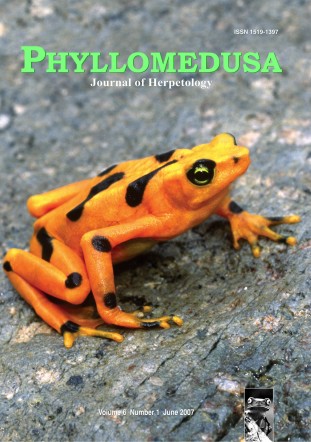Nocturnal position in the Panamanian Golden Frog, Atelopus zeteki (Anura, Bufonidae), with notes on fluorescent pigment tracking
DOI:
https://doi.org/10.11606/issn.2316-9079.v6i1p37-44Keywords:
Anura, Bufonidae, Atelopus zeteki, aposematic coloration, behavioral ecology, climbing, fluorescent pigmentAbstract
The endangered Panamanian golden frog, Atelopus zeteki, is a stream dweller of middle elevation rain forests of the Panamanian isthmus. In order to better understand this species for conservation, we set out to determine the nocturnal whereabouts of this diurnally active animal. It was expected that adult males and juveniles might occupy different nocturnal microhabitats based on differences in size, coloration and patterning. Findings presented here demonstrate that adult males climb significantly higher than juveniles at night and that movement distances to final resting positions also significantly differed. This change in diurnal and nocturnal position in adult males may be related to predator vigilance and avoidance. Lastly, this study demonstrated that individual rain forest amphibians can be successfully tracked over short to moderate distances in humid to wet environments using fluorescent pigments.Downloads
Download data is not yet available.
Downloads
Published
2007-06-01
Issue
Section
Articles
License
All material originally published in Phyllomedusa belongs to Escola Superior de Agricultura Luiz de Queiroz - Universidade de São Paulo. All contents are under a license of Creative Commons BY-NC-ND.How to Cite
Lindquist, E. D., Sapoznick, S. A., Rodriguez, E. J. G., Johantgen, P. B., & Criswell, J. M. (2007). Nocturnal position in the Panamanian Golden Frog, Atelopus zeteki (Anura, Bufonidae), with notes on fluorescent pigment tracking. Phyllomedusa: Journal of Herpetology, 6(1), 37-44. https://doi.org/10.11606/issn.2316-9079.v6i1p37-44



 Impact Factor (JCR): 0.600
Impact Factor (JCR): 0.600 CiteScore: 1.0
CiteScore: 1.0